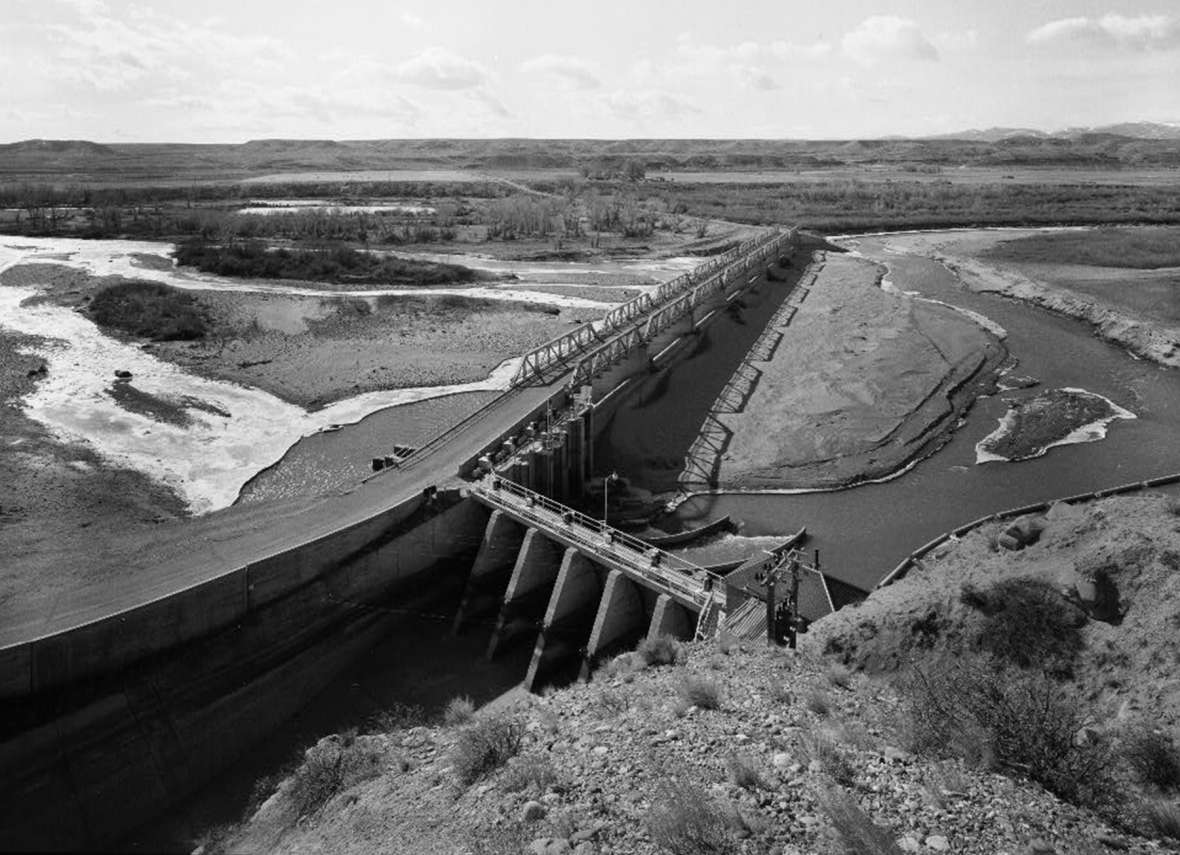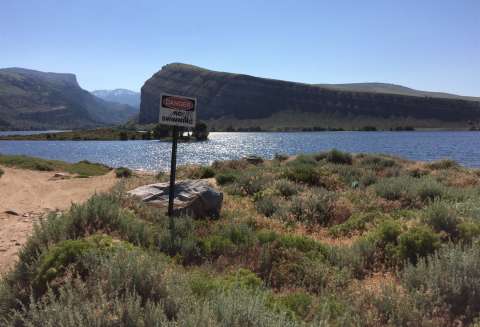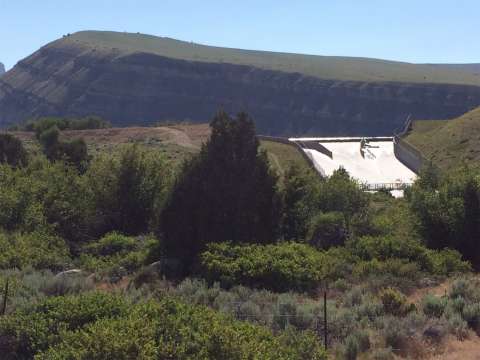- Home
- Encyclopedia
- Native Rights To Wind River Water
Native Rights to Wind River Water
Water can be scarce in arid Wyoming, but if the land is used lightly water is adequate. The water stored in winter snows in the mountains supports abundant game in the foothills, valleys and plains below.
The Eastern Shoshone and related people followed the game and the seasons for centuries, on lands now part of four states; in 1863 the lands they used were briefly recognized as their territory by treaty with the government of the growing United States. On July 3, 1868, however, a new treaty cut back those lands. The tribe was confined to a little more than 3 million acres, called at the time the Shoshone and ultimately the Wind River Reservation.
By guaranteeing the land would be reserved for the tribe, the U.S. government in the treaty was guaranteeing a right to the water on the land as well, courts would eventually rule. But it would take a century and a half for the courts to work out what water was whose—and to begin to define what tribal owners of the water could and couldn’t use their water for.
Many European-origin settlers of the surrounding new territory called Wyoming disliked the reservation and were gratified to see it diminish over the next 40 years as the Eastern Shoshone (and the Northern Arapaho, who were moved onto the reservation in 1878), were forced to sell off portions of the land to keep their people from starving as game herds dwindled. A final cession of land in 1905 for potential sale to settlers cut the reservation to one-quarter of its 1868 size.

Irrigation raises water rights questions
Most settlers tried agriculture. National policy sought to push the Shoshone and Arapaho people similarly into becoming farmers by breaking up the communal lands and herds of the reservation into private native family holdings. In Wyoming’s dry climate, agriculture required water for irrigation. Water wasn’t handy everywhere. People often had to divert it from rivers and creeks into dirt ditches to move it onto soils that could grow crops.
But significant questions soon arose: Who could claim how much water where, to raise a crop for cattle or people? The settlers on the periphery of the reservation took water under the laws of Wyoming Territory and, after 1890, the laws of the new state. After statehood, state law required that old water claims be examined to find out if the water was actually being used. New claims would be made by means of an application approved by the state and subject to deadlines, proof and examination to ensure that the water was actually used and stayed in use.
The date of a territorial claim, or of the permit application, gave the water user first rights—“priority”—to take water over others who applied later. On the Shoshone Reservation, as its officials followed through with Congressional policy to put native families onto private plots, superintendents, appointed from Washington, D.C., applied on behalf of those families for state water rights for those plots. Many of these applications were made just before the last big cession of a chunk of the reservation for potential sale to outsiders in 1905.
The Winters doctrine: treaties provide water rights
But the 1868 treaty had implications for water on Wind River that the superintendents did not grasp. What treaties could provide in water first became plain in northern Montana. Gros Ventre and Assiniboine people lived on a reservation on the Milk River that was in the same situation as the reservation on Wind River. Federal policy demanded native people become farmers, and farming required water, but settlers outside the reservation were claiming and diverting water faster than the native people.
The U.S. attorney in Montana, on behalf of the Milk River Reservation, launched a lawsuit that produced a major new ruling by the U.S. Supreme Court in 1908. The top court ruled that the treaty that created the reservation had necessarily, in an arid region, given the tribes rights to water for their needs.
The priority date of those rights would have to be the treaty date, and the volume of water the rights covered had to be enough to serve present and future needs. Because of the nature of a treaty setting aside a place for people to live and develop, the rights to water to serve that place could not be tied to a timetable or deadlines for putting the water to use. The name of the case that led to this decision was U.S. v. Winters, and the ruling became known as the “Winters doctrine.”
The Winters Doctrine applied to Wind River
Some Montana settlers welcomed that Supreme Court decision, hoping for subsequent federal investment for water development on the Milk River. Wyoming’s sole congressman, Frank Mondell, however, was among the critics. The Winters doctrine was soon applied on Wind River via lawsuits brought by the U.S. attorney in Wyoming to recognize 1868-date treaty water rights.
Wyoming’s first two federal judges, both prominent and knowledgeable in Wyoming society and politics, followed the U.S. Supreme Court Winters ruling and said Wind River reservation lands, and land now outside the reservation but allotted to native family plots, had water rights from the 1868 treaty. The first judge, John Riner, had been a member of the state constitutional convention that approved the basic outline of the state’s water-law system. The second, Blake Kennedy, was a leader in the dominant state Republican Party before he was rewarded with the federal judgeship.
Reservation superintendents did not tell people on the reservation about the lawsuit generating Riner’s decision until after he issued his ruling in 1916. While the case was pending, Reservation Superintendent H.E. Wadsworth told tribal leaders their people had only state water rights. He used the threat of state water deadlines to urge people to sell land off their family plots so they could buy horses and plows to get water on the land that remained before they lost the water.
In the early 1900s, the Indian irrigation office of the U.S. Department of Interior began but never completed an irrigation system for the reservation. Funding for the irrigation system depended on sales of the reservation lands that had been ceded in the 1905 agreement. Congress, in legislation Mondell lobbied hard for, had never promised to pay the Eastern Shoshone and Northern Arapaho for the ceded lands; the only promise was to have the Department of Interior act as broker selling the land to settlers.
But the land did not sell well. Those settlers who did come had a hard time getting irrigation. In 1919, the Department of Interior’s Reclamation Service (soon renamed the Bureau of Reclamation) took over the most ambitious failed effort and built the “Riverton Project,” now the Midvale Irrigation District. Construction was financed by money that Mondell managed to have allocated to it that year from Congress’ annual appropriations meant for Indian reservations.

Water rights long managed according to state, not treaty, water rights
In the hard years of the 1920s and 1930s, as native people and settlers found it a struggle to make a living in agriculture, treaty rights to Wind River water became a sleeping issue. The three irrigation districts around Riverton had water rights dated 1906; the state water rights that the reservation superintendent had applied for as the land cession had gotten underway were earlier, dated 1905; some non-Indian rights were decades earlier. State water officials managed the water diversions in priority order according to those dates.
Leading up to and after World War II, state officials allowed Midvale to use more and more water under its original 1906 water right. The district was, however, never a big agricultural success. Land use and ownership was a complicated mix of native people and settlers: Settlers leased or bought land on the reservation from native families, while native families also lived on lands served by the Riverton-area irrigation districts.
Following a successful Eastern Shoshone lawsuit against the United States, the Shoshone and then the Arapaho governments were able to re-acquire and develop some agricultural lands; ceded lands that had never sold were restored to the reservation in the 1940s. On the reservation and off, agriculture supported only some families, while other income came from oil, gas and uranium development.
Tribes assert treaty water rights and state takes case to court
Starting in the early 1960s, Winters treaty-based water rights received considerable legal and public attention, sparked by a major U.S. Supreme Court decision on water rights in the Colorado River. In 1975, the city of Riverton announced plans to drill for groundwater. Shoshone and Arapaho leaders challenged that, saying the tribes owned the groundwater under the 1868 treaty.

 On Jan. 22, 1977, Wyoming Gov. Ed Herschler signed an act passed by the Legislature to take the Wind River water issue to court. The Legislature wanted the issue decided in state court, which was possible only if the court followed federal law on Indian and federal water rights, and if the scope of the lawsuit included examination and adjudication of all water rights in the entire Wind-Bighorn River drainage. The lawsuit launched in 1977 was therefore immensely complex, involving 20,000-plus square miles and 20,000 water claimants. The case produced a series of decisions on different issues and reached final resolution only in 2014, after 37 years.
On Jan. 22, 1977, Wyoming Gov. Ed Herschler signed an act passed by the Legislature to take the Wind River water issue to court. The Legislature wanted the issue decided in state court, which was possible only if the court followed federal law on Indian and federal water rights, and if the scope of the lawsuit included examination and adjudication of all water rights in the entire Wind-Bighorn River drainage. The lawsuit launched in 1977 was therefore immensely complex, involving 20,000-plus square miles and 20,000 water claimants. The case produced a series of decisions on different issues and reached final resolution only in 2014, after 37 years.
Two key rulings come down
The key rulings on the case came in 1989 and 1992. Former Wyoming Congressman Teno Roncalio was the first “special master” that the state court appointed to hash through all the detailed evidence in the case. Roncalio issued an opinion broadly upholding the two tribes’ rights to most of the water in the Wind River—though not groundwater—to fill a variety of needs on the reservation, with the superior priority date of the 1868 treaty.
The Wyoming Supreme Court narrowed that decision by emphasizing that the treaty purpose for the reservation and the water was agriculture; but the court did support the overall volume of the water rights, dated 1868, to be available perpetually, not subject to use deadlines. The U.S. Supreme Court split on the issues and one justice bowed out due to conflict of interest, so in the end that court issued no opinion and simply affirmed the Wyoming court ruling on June 26, 1989. A little over half the water rights award was allocated based on the water needed for reservation lands historically irrigated, much of it from the Little Wind River. The rest of the award was allocated based on what could be needed for reservation lands that might be irrigated in the future from the main stem of the Wind River.
State high court restricts use of tribal rights
Neighboring irrigators and districts saw the “futures” water, in particular, as a threat. The increasing amount of water that Midvale, for instance, had used over time under its 1906 right would be bested by the 1868 date if the Shoshone and Arapaho people succeeded in using their “futures” rights.
The next Wyoming Supreme Court decision, on June 5, 1992, however, restricted how the native people could use their rights. The tribes in 1990 dedicated “futures” right to restoring flows in a stretch of the Wind River that for years had been largely dry in summer thanks to diversions to the major irrigation districts. Flowing water was a use valued and authorized by a new tribal water code. Wyoming had an in-stream flow law from 1986 but it was much narrower.
The state’s high court, in a decision prompting five opinions from the five justices who all had different reasoning, declared the tribes’ in-stream flow illegal. A bare majority agreed that the agricultural purpose the same court a few years earlier found in the treaty meant that the futures water rights had to be used for agriculture-related purposes, and the tribes must follow state water law in changing uses.
Fixing existing system, eyeing the future
In the nearly 30 years since 1991, rehabilitation has begun on the irrigation system on the reservation in the Little Wind River area, where use of even the “historic” water rights had fallen due to the dilapidated infrastructure, including collapsing ditch headgates. The tribal water engineer’s office has been building staff capacity to win state and federal funds for that rehabilitation and to take over management of the system. State funds have also helped improve drinking water systems on the reservation.
But little has changed on the main stem of the Wind River. Virtually no “futures” water rights are in use as of early 2019. The Wyoming Water Development Commission has funded studies for a reservoir in the upper reaches of the Wind River basin that could help put some of the futures rights in use for the tribes’ purposes, and provide some water-supply security for non-reservation irrigation. That would, however, require tribal-state agreement on location, management and funding. A way for the Eastern Shoshone and Northern Arapaho people to benefit from their full water rights has not yet emerged.
Editors’ Note: This and other 2018 and 2019 articles and digital toolkits on the history of tribal people in Wyoming are possible with support from the Wyoming Cultural Trust Fund, the Wyoming Council for the Humanities and several Wyoming school districts, including districts headquartered in Fort Washakie, Arapahoe, Shoshoni, Lander,
Resources
- “Big Horn General Stream Adjudication Symposium,” Wyoming Law Review15, no. 2 (September 2015): 233-312, 517-548.
- Hoopengarner, Molly. “To Make the Desert Bloom: How Irrigation Came to the Ceded Portion of the Wind River Indian Reservation.” Unpublished manuscript, 1991. Available in Fremont County libraries. Useful overall history of reservation to about 1915, and irrigation history on Midvale and nearby districts.
- O’Gara, Geoffrey. What You See in Clear Water: Life on the Wind River Reservation. New York: Knopf, 2000, 232-244.
- Shurts, John. Indian Reserved Water Rights: The Winters Doctrine in Its Social and Legal Context, 1880s–1930s. Norman: University of Oklahoma Press, 2000. Detailed overall history of the Winters case and its subsequent history into the 1930s.
- Wilson, Paul B. “Farming and Ranching on the Wind River Indian Reservation, Wyoming.” Ph.D. diss., University of Nebraska, 1972. Useful overall history of the reservation and its agriculture and water use, through the 1960s.
For further reading
- Midvale Irrigation District. “ Midvale Irrigation District History.” Accessed Feb. 11, 2019 at http://midvaleirrigation.net/History.aspx.
Illustrations
- The photo of Diversion Dam and its bridge, taken some time since 1968, is from the Library of Congress. Used with thanks.
- The other photos are by WyoHistory.org Editor Tom Rea.
